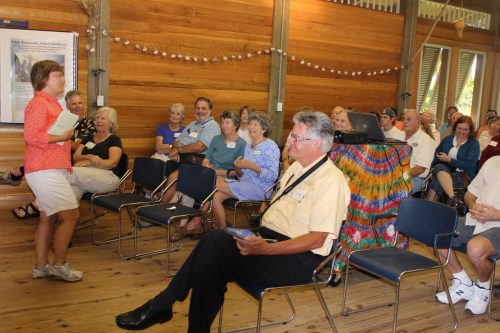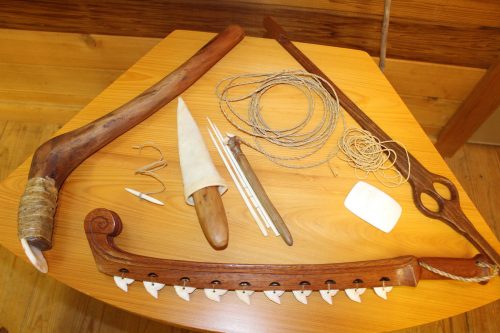In 2012, Cindy Bear and Bill Marquardt received a grant from the Arts and Attractions program of the Southwest Florida Community Foundation to enhance the visitor experience at the Calusa Heritage Trail.

October 18, 2013. Wall exhibit and Calusa net replica are
seen in the background. Photo by V. Amsler
The $14,520 grant was used to share the costs of enhancing two areas of prominent visitor interest: (1) a restored boardwalk to the Calusa burial mound, and (2) exhibits and hands-on artifact replicas in the classroom. The boardwalk project is finished, and the artifact replicas by Terry Powell have been delivered. A generous gift from Robert A. Wells, Jr. allowed us to expand the scope of the classroom exhibits on the Calusa Indians and their surroundings, which will now include answers to the questions most frequently asked by our visitors.
The original 125-foot boardwalk to the Smith Mound was built in 2004 to provide visitors access to the edge of the 25-foot-tall sand burial mound. The boardwalk traverses an area where standing water accumulates in wet weather and takes the visitor from interpretive signage describing Calusa spiritual practices to the base of the mound. Standing at the base of this mound, used by Calusa people from approximately 1,000 to 300 years ago, visitors find an emotional and personal connection to the people who lived on our site centuries ago.
However, the old boardwalk was in need of reconstruction. We wanted to elevate it slightly to reduce wood rot and to add a “toe-rail” for safety. A substructure was built of lumber and filled with a stabilizer material to prevent uneven settling of the structure and minimize warping. Mike’s Landscaping, a Pine Island business, donated the stabilizer material, valued at $450, and provided expert consultation at no cost. Major contributors to the design and implementation of the board-walk project were Alan Marcus, Jim Niehaus, Paul Carballo, Bob Crum, Ron Kerlin, and Gary Vinson. The boardwalk was completed and opened to the public in October.

room by Terry Powell. Photo by V. Amsler
We also wanted to improve the educational opportunities in our wheelchair-accessible classroom, which is typically the first and/or last area utilized by our visitors. The grant allowed us to add high quality exhibit panels with newly developed art and text, greatly enriching the visitor experience. The classroom exhibit planning phase included a visit to the RRC by Darcie MacMahon, Director of Exhibits for the Florida Museum of Natural History. Darcie met with Bill Marquardt, Cindy Bear, and RRC staff and volunteers, and led us in a conceptualization process based on the needs of our visitors. This process led to the decision to change our plans from one relying on pre-fabricated, stand-alone, permanent exhibit panels to a “poster” panel system, which will allow updating and modifications, complemented by replicas, display carts, and space for visitors to provide insights and questions.
The Florida Museum of Natural History provided expertise and assistance with the planned classroom exhibits, including text, images, graphics, and artifact replicas for display. RRC maintenance specialist Gary Vinson worked on the boardwalk improvement project and supervised volunteers. RRC staff member Cindy Bear devoted several weeks to text writing, consultation with teachers and museum professionals, and local coordination. RRC director Bill Marquardt contributed advice on content, exhibit design, and text writing, provided illustrations, and coordinated with graphic designer Nancy Koucky.
More than 40 people attended a boardwalk ribbon-cutting and sneak preview of the classroom enhancements on October 18, 2013. Some came from as far away as Buckingham, and several came by boat from Useppa Island. There was much enthusiasm about the newly replicated Calusa artifacts, which include a splendid fishing net that was artfully suspended from the wall. Several of the interpretive posters had already been delivered and they generated much interest and positive comments. Cindy Bear gave an introduction and welcome, thanking donors of funds and in-kind services. Then Bill Marquardt gave a talk entitled “A Brief Look at Calusa Technology and Architecture.” Then the entire group strolled to the Smith Mound where a “ribbon” of grape vines and flowers (made for the occasion by Martha Kendall) was cut, opening access to the new boardwalk. The group gathered at the Smith Mound edge, and asked many questions about the Calusa and their beliefs. The event was reported by Ed Franks in the Pine Island Eagle. Nancy MacPhee, Program Director for Marketing, represented the Lee County Tourist Development Council, which sponsors the Arts and Attractions grants program.
We welcome everyone to come walk the new structure and view the new classroom materials. And, with the cooler weather, this is a great time to renew your acquaintance with the Calusa Heritage Trail. See you there!
This article was taken from the Friends of the Randell Research Center Newsletter Vol 12, No. 4. December 2013.